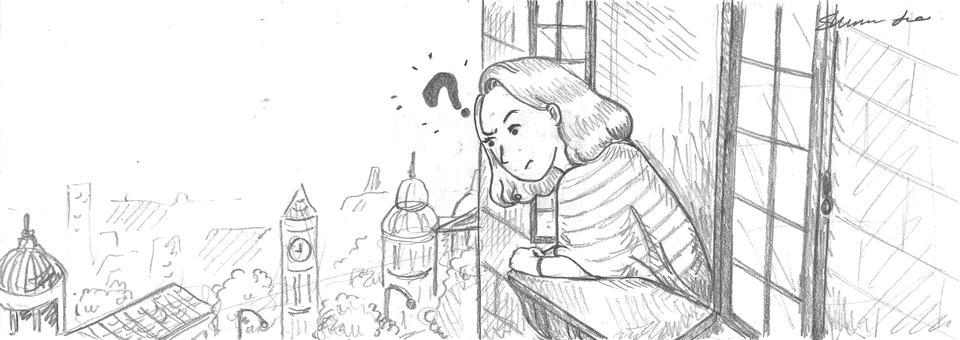
News
HMS Is Facing a Deficit. Under Trump, Some Fear It May Get Worse.

News
Cambridge Police Respond to Three Armed Robberies Over Holiday Weekend

News
What’s Next for Harvard’s Legacy of Slavery Initiative?

News
MassDOT Adds Unpopular Train Layover to Allston I-90 Project in Sudden Reversal

News
Denied Winter Campus Housing, International Students Scramble to Find Alternative Options
Heavy-Handed 'History' of Nazi Germany Forces Points
"The History of History" by Ida Hattemer-Higgins (Knopf)

Absurdist literature is at its best in works like those of Franz Kafka; his characters weave through bureaucratic mazes and grapple with harrowing transformations in themselves and others as if they are natural occurrences. Absurdity is everywhere in Kafka’s stories, but his characters rarely question the irrational things that happen to them.
Ida Hattemer-Higgins’ debut novel “The History of History” opens with a simple absurdist premise: young American expatriate Margaret Taub awakens alone in the woods outside Berlin wearing tattered men’s clothes and unable to recall the past several months of her life. As Margaret attempts to reconstruct her recent past, she begins to explore the country’s Nazi history and to identify personally with it—experiencing Germany’s past through a series of hallucinations, meetings with a blind doctor, and sympathetic late night readings of Nazi dictator Adolf Hitler’s “Mein Kampf.” But while Kafka’s characters accept absurdity as part of the human condition, both Margaret and Hattemer-Higgins’ narrator seem constantly incredulous at the changes she undergoes. These incredulous remarks and digressions result in scattered plotlines and clunky prose, ridden with clichés.
Berlin would seem to be the perfect setting for an absurdist plot; over time, it has been the center of several empires, the hub of the Third Reich, and split by the Berlin Wall for three decades. It is a city accustomed to accepting irrational divisions as commonplace. But when Margaret leaves her apartment one morning to find that the façade of every building in Berlin has turned into living flesh, the narrator begs the reader to accept her twist. “Something occurred which might tax the reader’s imagination to believe,” Hattemer-Higgins writes, “but this thing that happened – it must be believed.” Such a blatant shift in the narrator’s tone, a sudden direct plea to the reader, is exactly the type of ploy that calls into question the merit of Hattemer-Higgins’ hallucinatory premise; by forcing her points, she undercuts their effectiveness.
Hattemer-Higgins’ prose seems to strive for plausibility and understanding. Margaret does not encounter other characters; the author seems to drop them into the prose, but never takes the time to fully integrate them into the story. “And then, by chance, a new person appeared,” the narrator begins an account of the brief meeting between Margaret and a Nazi officer who witnessed Hitler’s suicide. “[H]e walked into Margaret’s life, and it was the reality, rather than the unreality, that threw down the gauntlet this time. Berlin had yet another trick up its sleeve.” The narrator does not give this man the space to demonstrate his importance through a role in the story; it is painfully clear that Hattemer-Higgins’ relies on clichés to introduce him.
In her prose, cliché is a bulwark against the possibilities of ambiguity and imagination. As Margaret continues on her quest to reconstruct the past several months, the narrator never refrains from dictating how readers should respond. Allusions, metaphors, signifiers, and foreshadowing events are rarely left to interpretation. It is as if the novel can only proceed in one direction, and the narrator is content merely to push it down that predetermined path. It is not long before Hattemer-Higgins’ heavy-handed prose becomes the enemy of her suspense.
However, her talent is apparent when she abandons her attempts at surrealism. When she forgoes the buildings of flesh, the endless rope ladders hanging from the sky over Berlin, and the zombie-hawk phantom of Joseph Goebbels’ wife, Hattemer-Higgins stops forcing the storyline and allows it to develop on its own.
Hattemer-Higgins succeeds instead in her descriptions of everyday life and less obviously absurd events. In one instance, the ghost of a Holocaust victim explains a simple allegory to the reader at length, ensuring that its meaning is properly understood. She then poetically recalls her childhood travels in Switzerland. In these recollections, Hattemer-Higgins allows the pressured family dynamic to speak for itself, and does not try to interpret the events; her restraint lends the passage a subtlety that the novel lacks as a whole. Even Margaret’s memories, on which the narrator is generally all too willing to comment, are expressed smoothly when rid of their absurdist pretensions. Describing Margaret’s grandfather visiting her years earlier, the narrator writes, “Her mother fixed up the back bedroom for him, and he, in the wide guest bed, kept the venetian blinds almost opaque, the sounds of ambulance sirens circling up to the twelfth floor.” Here, Hattemer-Higgins renders the mundane melodic. She allows her prose to expand naturally and the reader to interpret freely.
When Margaret is finally able to retrieve the missing months of her life, Higgins begins to tell a coherent story. Perhaps taking on the historical guilt of an entire country is too ambitious a feat. The cruelty of Nazi Germany is too broad for Hattemer-Higgins to encompass in her narrative. She is most incisive when she confines herself to the brief history of one woman, to Margaret’s acts of betrayal and personal guilt, and to the quotidian aspects of life.
—Staff writer Renee G. Stern can be reached at rstern@college.harvard.edu.
Want to keep up with breaking news? Subscribe to our email newsletter.
